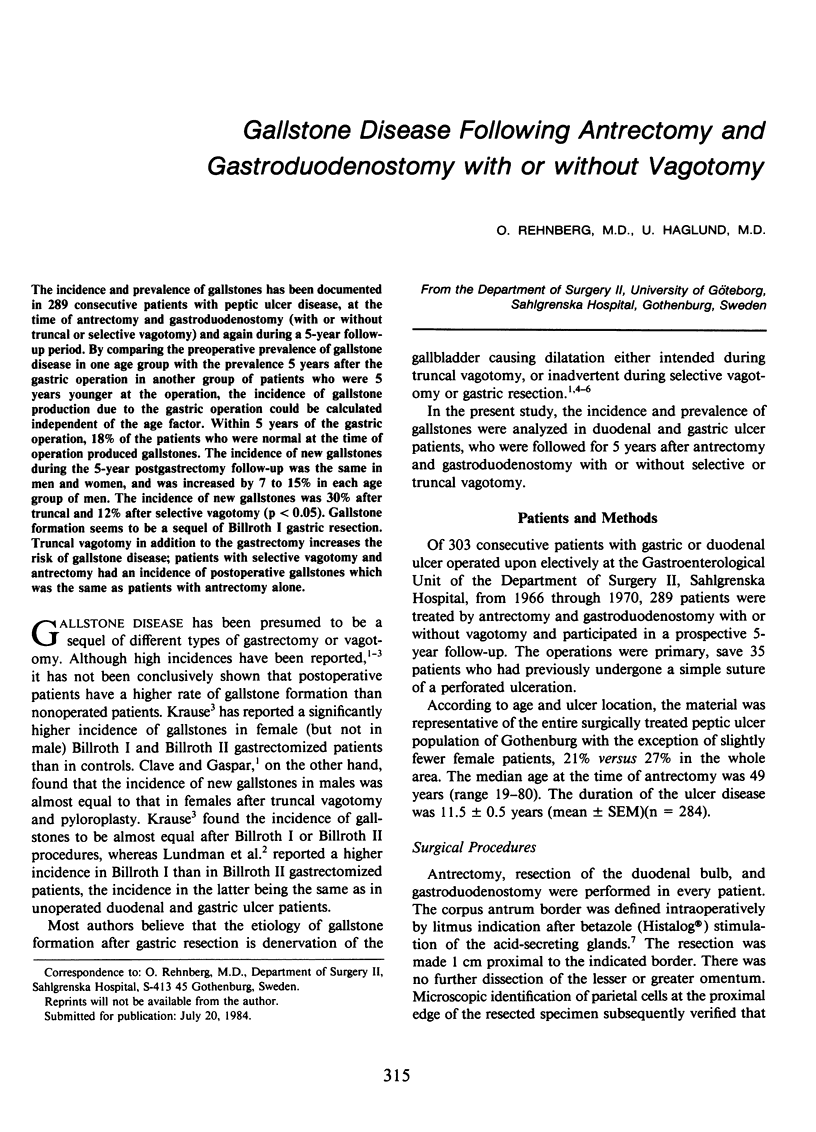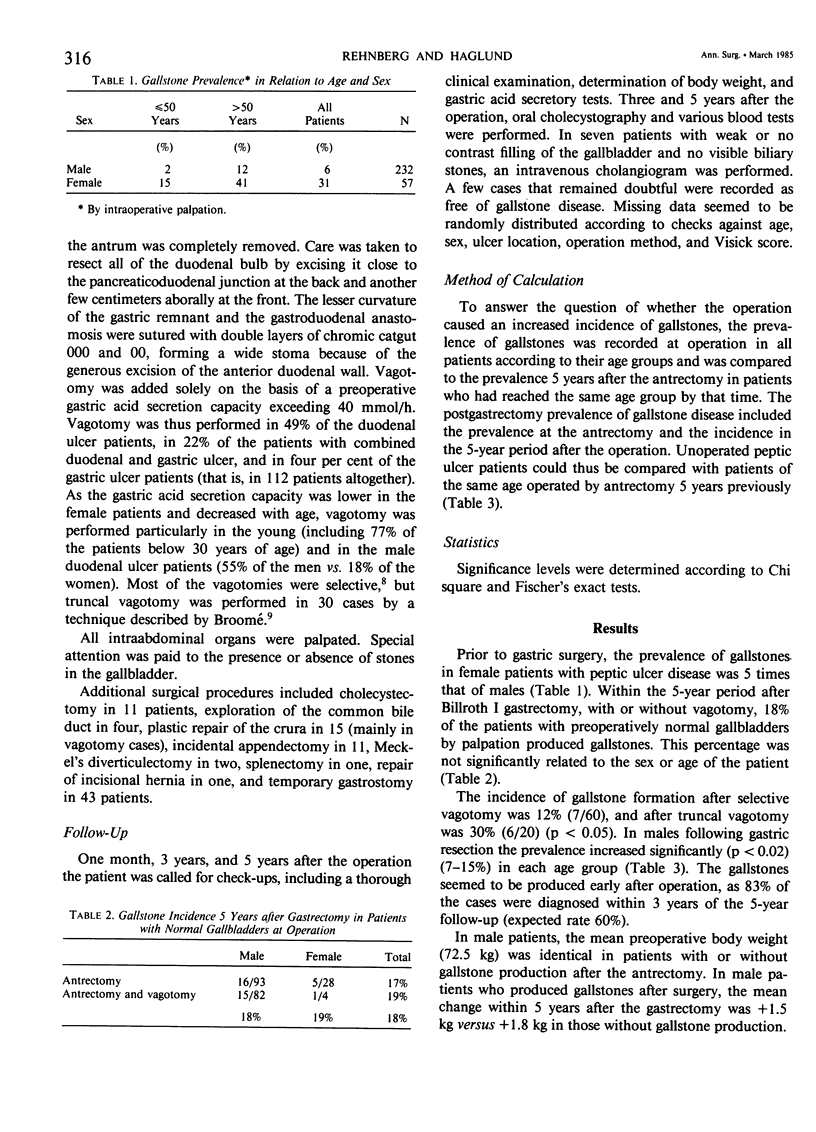Abstract
The incidence and prevalence of gallstones has been documented in 289 consecutive patients with peptic ulcer disease, at the time of antrectomy and gastroduodenostomy (with or without truncal or selective vagotomy) and again during a 5-year follow-up period. By comparing the preoperative prevalence of gallstone disease in one age group with the prevalence 5 years after the gastric operation in another group of patients who were 5 years younger at the operation, the incidence of gallstone production due to the gastric operation could be calculated independent of the age factor. Within 5 years of the gastric operation, 18% of the patients who were normal at the time of operation produced gallstones. The incidence of new gallstones during the 5-year postgastrectomy follow-up was the same in men and women, and was increased by 7 to 15% in each age group of men. The incidence of new gallstones was 30% after truncal and 12% after selective vagotomy (p less than 0.05). Gallstone formation seems to be a sequel of Billroth I gastric resection. Truncal vagotomy in addition to the gastrectomy increases the risk of gallstone disease; patients with selective vagotomy and antrectomy had an incidence of postoperative gallstones which was the same as patients with antrectomy alone.
Full text
PDF



Selected References
These references are in PubMed. This may not be the complete list of references from this article.
- ALDERSON D. A. The reliability of telepaque cholecystography. Br J Surg. 1960 May;47:655–658. doi: 10.1002/bjs.18004720612. [DOI] [PubMed] [Google Scholar]
- Amdrup E., Clemmesen T., Andreassen J. Selective gastric vagotomy technic and primary results. Am J Dig Dis. 1967 Apr;12(4):351–355. doi: 10.1007/BF02241936. [DOI] [PubMed] [Google Scholar]
- BERGSTROEM H., BROOME A. PEROPERATIVE DETERMINATION OF THE BOUNDARY BETWEEN THE GASTRIC ANTRUM AND FUNDUS. Acta Chir Scand. 1964 Nov;128:526–529. [PubMed] [Google Scholar]
- Broomé A., Bergström H., Olbe L. Maximal acid response to histamine in duodenal ulcer patients subjected to resection of the antrum and duodenal bulb followed by vagotomy. Gastroenterology. 1967 Jun;52(6):952–958. [PubMed] [Google Scholar]
- COX H. T., DOHERTY J. F., KERR D. F. Changes in the gallbladder after elective gastric surgery. Lancet. 1958 Apr 12;1(7024):764–766. doi: 10.1016/s0140-6736(58)91575-7. [DOI] [PubMed] [Google Scholar]
- Clave R. A., Gaspar M. R. Incidence of gallbladder disease after vagotomy. Am J Surg. 1969 Aug;118(2):169–176. doi: 10.1016/0002-9610(69)90116-0. [DOI] [PubMed] [Google Scholar]
- Fletcher D. M., Clark C. G. Changes in canine bile-flow and composition after vagotomy. Br J Surg. 1969 Feb;56(2):103–106. doi: 10.1002/bjs.1800560205. [DOI] [PubMed] [Google Scholar]
- Friedman G. D., Kannel W. B., Dawber T. R. The epidemiology of gallbladder disease: observations in the Framingham Study. J Chronic Dis. 1966 Mar;19(3):273–292. doi: 10.1016/0021-9681(66)90132-9. [DOI] [PubMed] [Google Scholar]
- Inberg M. V., Vuorio M. Human gallbladder function after selective gastric and total abdominal vagotomy. Acta Chir Scand. 1969;135(7):625–633. [PubMed] [Google Scholar]
- JOHNSON F. E., BOYDEN E. A. The effect of double vagotomy on the motor activity of the human gall bladder. Surgery. 1952 Sep;32(3):591–601. [PubMed] [Google Scholar]
- LUNDMAN T., ORINIUS E., THORSEN G. INCIDENCE OF GALLSTONE DISEASE FOLLOWING PARTIAL GASTRIC RESECTION. Acta Chir Scand. 1964 Jan-Feb;127:130–133. [PubMed] [Google Scholar]
- Parkin G. J., Smith R. B., Johnston D. Gallbladder volume and contractility after truncal, selective and highly selective (parietal-cell) vagotomy in man. Ann Surg. 1973 Nov;178(5):581–586. doi: 10.1097/00000658-197311000-00005. [DOI] [PMC free article] [PubMed] [Google Scholar]
- RUDICK J., HUTCHISON J. S. EFFECTS OF VAGAL-NERVE SECTION ON THE BILIARY SYSTEM. Lancet. 1964 Mar 14;1(7333):579–581. doi: 10.1016/s0140-6736(64)91330-3. [DOI] [PubMed] [Google Scholar]
- RUDICK J., HUTCHISON J. S. EVALUATION OF VAGOTOMY AND BILIARY FUNCTION BY COMBINED ORAL CHOLECYSTOGRAPHY AND INTRAVENOUS CHOLANGIOGRAPHY. Ann Surg. 1965 Aug;162:234–240. doi: 10.1097/00000658-196508000-00010. [DOI] [PMC free article] [PubMed] [Google Scholar]
- Smith D. C., Crook J. N., McAllister R., MacKay C. The comparison of gallbladder bile in patients with gallstones and in patients with duodenal ulcer before and after vagotomy. Br J Surg. 1972 Apr;59(4):306–306. [PubMed] [Google Scholar]
- Stempel J. M., Duane W. C. Bilary lipids and bile acid pool size after vagotomy in man. Evidence against a predisposition to gallstones. Gastroenterology. 1978 Oct;75(4):608–611. [PubMed] [Google Scholar]
- Tompkins R. K., Kraft A. R., Zimmerman E., Lichtenstein J. E., Zollinger R. M. Clinical and biochemical evidence of increased gallstone formation after complete vagotomy. Surgery. 1972 Feb;71(2):196–200. [PubMed] [Google Scholar]
- Zahor A., Sternby N. H., Kagan A., Uemura K., Vanecek R., Vichert A. M. Frequency of cholelithiasis in Prague and Malmö. An autopsy study. Scand J Gastroenterol. 1974;9(1):3–7. [PubMed] [Google Scholar]


